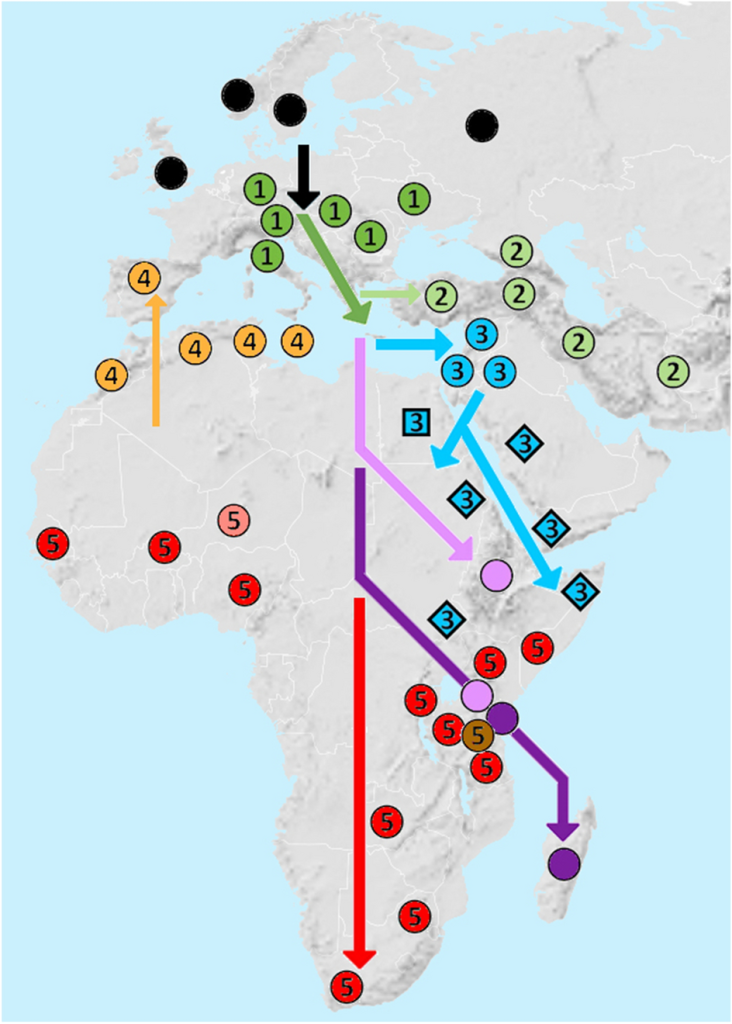Multiple mitogenomes indicate Things Fall Apart with Out of Africa or Asia hypotheses for the phylogeographic evolution of Honey Bees (Apis mellifera)
- Steven M. Carr
Scientific Reports volume 13, Article number: 9386 (2023) Cite this article
Abstract

Figure 3 From: Multiple mitogenomes indicate Things Fall Apart with Out of Africa or Asia hypotheses for the phylogeographic evolution of Honey Bees (Apis mellifera)
Previous morpho-molecular studies of evolutionary relationships within the economically important genus of honey bees (Apis), including the Western Honey Bee (A. mellifera L.), have suggested Out of Africa or Asia origins and subsequent spread to Europe. I test these hypotheses by a meta-analysis of complete mitochondrial DNA coding regions (11.0 kbp) from 22 nominal subspecies represented by 78 individual sequences in A. mellifera. Parsimony, distance, and likelihood analyses identify six nested clades: Things Fall Apart with Out of Africa or Asia hypotheses. Molecular clock-calibrated phylogeographic analysis shows instead a basal origin of A. m. mellifera in Europe ~ 780 Kya, and expansion to Southeast Europe and Asia Minor ~ 720 Kya. Eurasian bees spread southward via a Levantine/Nilotic/Arabian corridor into Africa ~ 540 Kya. An African clade re-established in Iberia ~ 100 Kya spread thereafter to westerly Mediterranean islands and back into North Africa. Nominal subspecies within the Asia Minor and Mediterranean clades are less differentiated than are individuals within other subspecies. Names matter: paraphyletic anomalies are artefacts of mis-referral in GenBank of sequences to the wrong subspecies, or use of faulty sequences, which are clarified by inclusion of multiple sequences from available subspecies.
Phylogeographic evolution in context of geographic distribution2 of subspecies of A. mellifera as inferred from mitogenomic data. Numbered symbols indicate five clades described in the text and in Fig. 2. Dark and light green circles indicate respectively subspecies in the Southeast European and Asia Minor clades included within the Eurasian superclade. Blue symbols indicate the Levantine (circles), Nilotic (squares), and Arabian (A. m. jemenitica) (diamonds) clades. Light and dark purple circles indicate independent A. m. simensis and A. m. unicolor lineages, respectively. Light orange symbols indicate subspecies in the Mediterranean clade. Red circles indicate the paraphyletic assemblage of A. m. scutellata and A. m. capensis, including A. m. adansonii (light red) and A. m. monticola (brown). Base map modified from [https://commons.wikimedia.org/wiki/File:BlankMap-World.svg].
We are here to share current happenings in the bee industry. Bee Culture gathers and shares articles published by outside sources. For more information about this specific article, please visit the original publish source: Multiple mitogenomes indicate Things Fall Apart with Out of Africa or Asia hypotheses for the phylogeographic evolution of Honey Bees (Apis mellifera) | Scientific Reports (nature.com)






